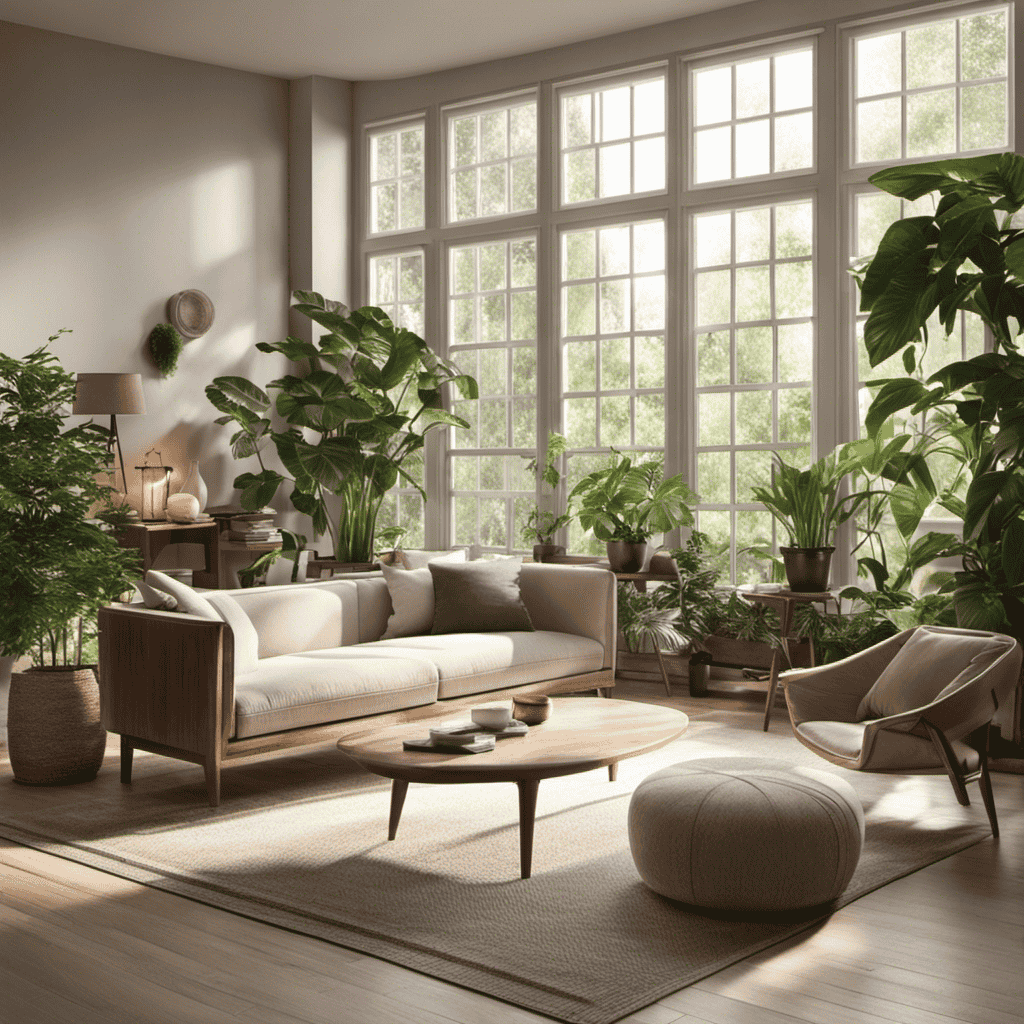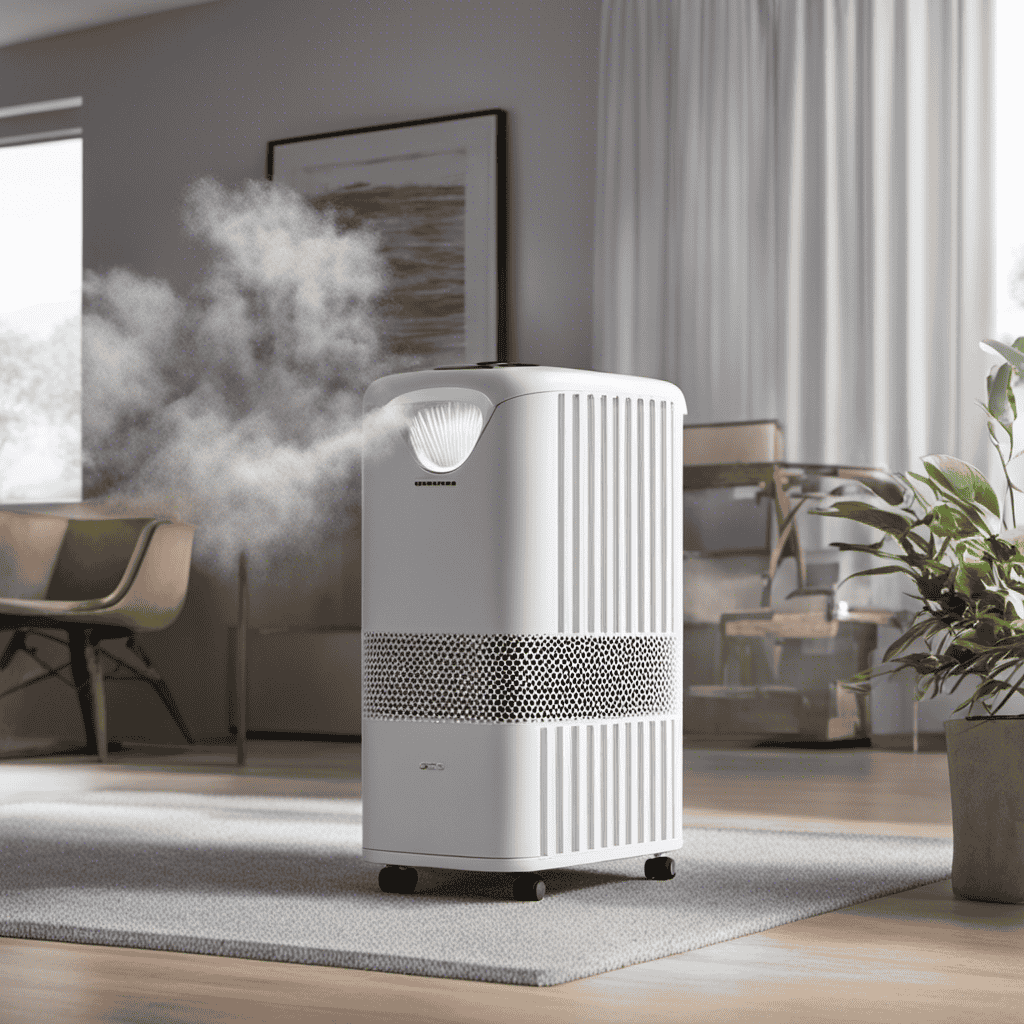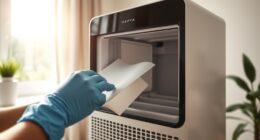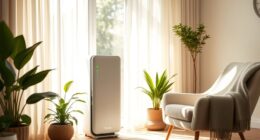I understand your concern – is it truly necessary to have my air purifier running constantly? Let me assure you, there are several important reasons why keeping your air purifier running regularly can significantly improve the quality of your indoor air.
In this article, we will dive into the factors to consider in determining air purifier runtime, the recommended frequency for running it, and how long each session should be. We’ll also explore the impact of air quality, efficiency, and seasonal changes on your air purifier’s operation.
So, buckle up and get ready to optimize your air purifier runtime for maximum effectiveness and energy efficiency.
Key Takeaways
- The frequency of air purifier operation depends on individual needs, allergies, pollution levels, and indoor air quality.
- Regular maintenance and filter replacement are essential for efficient operation.
- Monitoring indoor air quality using sensors or air quality monitors is important.
- Adjusting air purifier operation according to seasonal changes, temperature, and humidity levels can optimize performance.
Benefits of Running Your Air Purifier Regularly
You should run your air purifier regularly because it helps to remove allergens and improve the air quality in your home. Air purifier maintenance is crucial to ensure its optimal performance. Regularly cleaning and replacing the filters is essential. It is recommended to clean the pre-filter every two weeks and replace it every three months. The HEPA filter, responsible for capturing small particles, should be replaced every six to twelve months, depending on the manufacturer’s instructions. Additionally, keeping the air purifier in a clean environment, away from dust and debris, will prevent clogging and prolong its lifespan.
Now, let’s discuss the best time to run your air purifier. Ideally, it is recommended to run the air purifier continuously to maintain a consistently clean environment. However, if you prefer to conserve energy or if you’re leaving your home for an extended period, you can adjust the settings accordingly. It’s important to note that the effectiveness of an air purifier relies on its circulation and filtration capabilities. Therefore, running it in high-traffic areas, such as living rooms and bedrooms, during the day and night will provide the best results.
Factors to Consider in Determining Air Purifier Runtime
When determining the runtime for your air purifier, it is essential to take into account various factors that can affect its efficiency and effectiveness.
Room size, air quality, and the presence of allergens are crucial considerations to ensure that your air purifier is running for the recommended duration.
Firstly, the size of the room plays a significant role in determining the runtime of your air purifier. Larger rooms generally require longer runtimes to ensure that all the air in the space is effectively cleaned and purified. Smaller rooms, on the other hand, may require shorter runtimes as the air can be circulated and purified more quickly.
Secondly, the air quality in your environment is another critical factor to consider. If you live in an area with poor outdoor air quality or if you have indoor pollutants such as smoke, pet dander, or dust, you may need to run your air purifier for longer periods to maintain clean and healthy air.
Lastly, the presence of allergens is an important consideration. If you or your family members suffer from allergies or asthma, it is recommended to run the air purifier continuously or for extended periods to reduce the presence of allergens in the air and alleviate symptoms.
In addition to determining the recommended runtime for your air purifier, it is equally important to prioritize regular maintenance. Cleaning or replacing filters, checking for any blockages, and ensuring proper airflow are essential maintenance tasks that can significantly impact the performance and longevity of your air purifier. Regular maintenance not only ensures optimal air purification but also prolongs the lifespan of the device.
To summarize, when determining the runtime for your air purifier, consider factors such as room size, air quality, and the presence of allergens. It is also crucial to prioritize regular maintenance to maximize the performance and lifespan of your air purifier. By taking these factors into account and following recommended guidelines, you can ensure that your air purifier is operating efficiently, providing clean and healthy air for you and your family.
Recommended Frequency for Running an Air Purifier
When it comes to the optimal running duration of an air purifier, several factors come into play. These factors can greatly impact the effectiveness and efficiency of the device.
Understanding these factors is crucial in determining the recommended frequency for running an air purifier and ensuring its maximum performance.
Optimal Running Duration
The optimal duration to run your air purifier is typically around 8-12 hours a day. This ensures that the air in your home is constantly being purified without putting too much strain on the device. Running it for longer periods may not necessarily provide added benefits, as the air quality reaches a plateau after a certain point. It is important to find the right balance between usage and energy consumption. To help you understand the recommended duration and optimal frequency, I have prepared a table below:
| Optimal Duration (Hours) | Optimal Frequency |
|---|---|
| 8 | Daily |
| 10 | Every Other Day |
| 12 | Every Three Days |
Factors Affecting Usage?
Factors that can impact the usage of an air purifier include room size, air pollution levels, and the presence of allergens or odors. These factors play a crucial role in determining the efficiency of an air purifier.
The size of the room is important because it affects the purifier’s ability to circulate and clean the air effectively. A larger room may require a more powerful purifier or multiple units to achieve the desired results.
Air pollution levels also play a significant role. Higher levels of pollution require the purifier to work harder and may result in more frequent filter replacements.
Finally, the presence of allergens or odors can impact the purifier’s performance. If there are high levels of allergens or strong odors present, the purifier may need to run for longer periods to effectively eliminate them.
Therefore, understanding these factors is crucial in optimizing the usage of an air purifier and ensuring clean and healthy indoor air quality.
How Long Should You Run Your Air Purifier Each Time
One important consideration is how long you should run your air purifier each time. The optimal running time for an air purifier depends on various factors such as the size of the room, the air quality, and the specific model you have.
In general, it’s recommended to run your air purifier for at least 8 hours a day to effectively clean the air in your space. However, if you have severe allergies or live in an area with high pollution levels, you may want to consider running it for longer periods, such as overnight or continuously.
To maximize the effectiveness of your air purifier, there are a few tips you can follow. Firstly, make sure to place the air purifier in a central location in the room to allow for maximum air circulation. Additionally, keep windows and doors closed while the purifier is running to prevent outside pollutants from entering the room.
Regularly cleaning or replacing the filters is also crucial for maintaining the efficiency of the air purifier. Lastly, consider investing in a purifier with a built-in timer or programmable settings, as this can help you customize the running time based on your specific needs.
The Impact of Air Quality on Air Purifier Usage
In order to ensure optimal performance and efficiency of your air purifier, proper maintenance is essential. Regular maintenance includes cleaning and replacing the air purifier filters. Here are some important points to consider regarding air purifier maintenance and air purifier filters:
-
Cleaning the filters: Depending on the model of your air purifier, the filters may need to be cleaned on a regular basis. This can usually be done by gently vacuuming or washing the filters with water and mild detergent. It is important to follow the manufacturer’s instructions for proper cleaning techniques.
-
Replacing the filters: Over time, the filters in your air purifier will become less effective at capturing airborne particles. It is recommended to replace the filters as per the manufacturer’s guidelines. This will ensure that your air purifier continues to provide clean and fresh air.
-
Checking the filter indicator: Many air purifiers have a filter replacement indicator that alerts you when it’s time to change the filters. Pay attention to these indicators to ensure that you are replacing the filters at the right time.
-
Professional servicing: If you are unsure about how to clean or replace the filters, or if you notice any issues with your air purifier, it is advisable to seek professional servicing. They can provide expert guidance and ensure that your air purifier is functioning effectively.
Proper maintenance of your air purifier and regular replacement of filters are vital to its performance. By following these guidelines, you can ensure that your air purifier continues to improve the air quality in your home or office.
With this in mind, let’s explore the recommended air purifier usage guidelines for different room sizes.
Air Purifier Usage Guidelines for Different Room Sizes
When determining the appropriate air purifier for a specific room size, it’s important to consider the square footage and choose a model that is suitable. Air purifiers are designed to clean the air by removing harmful pollutants, such as dust, allergens, and bacteria. They work by drawing in the surrounding air and passing it through a series of filters that capture these pollutants.
Regular air purifier maintenance is essential to ensure optimal performance and efficiency.
To determine the right size of air purifier for your room, you need to calculate the square footage. This can be done by measuring the length and width of the room and multiplying them together. Once you have the square footage, you can refer to the manufacturer’s guidelines to choose the appropriate model. It’s important to note that using an undersized air purifier may not adequately clean the air, while using an oversized one may consume unnecessary energy.
Air purifiers offer numerous benefits in reducing pollutants. They can help alleviate symptoms associated with allergies and asthma by capturing and filtering out allergens like dust mites, pollen, and pet dander. Additionally, air purifiers can help minimize the presence of harmful volatile organic compounds (VOCs) emitted by household cleaning products and other sources.
Regular maintenance, including cleaning or replacing filters as recommended by the manufacturer, ensures that the air purifier continues to effectively reduce pollutants and maintain healthy indoor air quality.
The Relationship Between Air Purifier Efficiency and Runtime
To maximize efficiency and runtime, it’s crucial to regularly clean or replace the filters in your air purifier as recommended by the manufacturer. Neglecting filter maintenance can significantly impact the effectiveness of your air purifier, as various factors can affect its performance.
Here are the key factors to consider and the recommended maintenance schedule for filters:
-
Filter Type: Different air purifiers use different types of filters, such as HEPA filters, activated carbon filters, or electrostatic filters. Each type has its own lifespan and requires specific maintenance. Consult the manufacturer’s guidelines to determine the recommended replacement schedule for your specific filter type.
-
Air Quality: The air quality in your environment plays a significant role in filter effectiveness. If you live in an area with high pollution levels or have pets or smokers in your home, the filters may become clogged more quickly. In such cases, it’s important to check and clean the filters more frequently.
-
Usage: The frequency and duration of air purifier usage also impact filter lifespan. If you run your air purifier continuously or for extended periods, the filters may become saturated with pollutants faster. Regularly inspect and clean the filters to maintain optimal performance.
-
Manufacturer Recommendations: The manufacturer of your air purifier will provide specific guidelines for filter maintenance and replacement. Follow these recommendations to ensure your air purifier operates at its best and maintains its efficiency and runtime.
Signs That Indicate Your Air Purifier Needs to Be Run More Often
Poor indoor air quality can have a significant impact on our health, particularly for those with allergies. When the air quality in our homes is compromised, it can lead to an increase in allergy symptoms such as sneezing, coughing, and watery eyes.
Understanding the link between poor indoor air quality and increased allergy symptoms is crucial for implementing effective measures to improve air quality and alleviate allergy discomfort.
Poor Indoor Air Quality
If you’re experiencing poor indoor air quality, running your air purifier regularly can help improve it. Indoor air quality is a growing concern due to increasing pollution levels, which can have detrimental effects on our health. Here are four reasons why running your air purifier is essential:
-
Filtering out pollutants: Air purifiers use filters to trap harmful particles such as dust, pollen, pet dander, and smoke, reducing their presence in the air.
-
Eliminating allergens: By capturing allergens like mold spores and dust mites, air purifiers can alleviate allergy symptoms and provide relief to those with respiratory conditions.
-
Removing volatile organic compounds (VOCs): Air purifiers with activated carbon filters can effectively remove VOCs emitted by cleaning products, paints, and furniture, reducing their potential health risks.
-
Enhancing overall air circulation: Air purifiers help to circulate and filter the air in a room, ensuring a constant supply of clean and fresh air.
Increased Allergy Symptoms
When allergies worsen, using an air purifier can provide relief by capturing allergens and improving the air quality in your home.
Increased allergy symptoms can be caused by a variety of irritants, such as pollen, dust mites, pet dander, and mold spores. These allergens can trigger sneezing, itching, nasal congestion, and other uncomfortable symptoms.
To reduce allergens in the home, it is important to keep your living space clean and well-ventilated. Regular vacuuming, dusting, and washing bedding can help remove allergens from surfaces.
Additionally, using air purifiers with high-efficiency particulate air (HEPA) filters can effectively remove airborne allergens. HEPA filters can capture particles as small as 0.3 microns, including pollen, pet dander, and dust mites.
The Influence of Seasonal Changes on Air Purifier Operation
To maintain optimal air quality in your home, you should adjust the operation of your air purifier according to the seasonal changes. Temperature fluctuations can have a significant influence on the efficiency of your air purifier and its ability to alleviate symptoms of seasonal allergies.
Here are four ways in which seasonal changes can impact the operation of your air purifier:
-
Temperature and Humidity Levels: As the seasons change, so do the temperature and humidity levels in your home. Higher temperatures and humidity can promote the growth of mold and bacteria, which can reduce the effectiveness of your air purifier. Adjusting the settings of your air purifier to accommodate these changes can help maintain optimal air quality.
-
Pollen and Allergen Levels: Different seasons bring different allergens. During spring and summer, pollen levels are typically higher, leading to increased allergy symptoms. By increasing the operation of your air purifier during these seasons, you can remove more pollen and other allergens from the air, providing relief for seasonal allergy sufferers.
-
Seasonal Pollutants: Seasonal changes can also bring different pollutants into your home. For example, during winter, when houses are closed up and heating systems are in use, indoor air pollution can increase due to the release of chemicals from household products and heating sources. Adjusting the operation of your air purifier can help remove these pollutants and maintain indoor air quality.
-
Air Circulation: The air circulation in your home can also be affected by seasonal changes. For instance, during summer, when windows are open and more outdoor air is circulating in your home, you may need to increase the operation of your air purifier to combat the influx of outdoor pollutants.
In conclusion, understanding the influence of temperature fluctuations and seasonal allergies on air purifier efficiency is crucial for maintaining optimal air quality in your home. By adjusting the operation of your air purifier according to the changing seasons, you can ensure that it is running at its highest efficiency and providing the best possible relief for seasonal allergy sufferers.
Now, let’s explore how to optimize air purifier runtime for energy efficiency.
How to Optimize Air Purifier Runtime for Energy Efficiency
To optimize the runtime of your air purifier for energy efficiency, consider using the timer feature to schedule when it operates throughout the day. This way, you can ensure that the air purifier is running when it is most needed, while also reducing unnecessary energy consumption. Proper air purifier maintenance and following a few simple tips can further help in reducing energy consumption.
One important aspect of air purifier maintenance is regular cleaning of the filters. Dirty filters can restrict airflow and cause the air purifier to work harder, consuming more energy. It is recommended to clean or replace the filters as per the manufacturer’s instructions. Additionally, placing the air purifier in an area with good air circulation can help in optimizing its performance.
Here are some tips for reducing energy consumption while using an air purifier:
| Tip | Description |
|---|---|
| Adjust the fan speed | Lowering the fan speed can help in reducing energy consumption. |
| Use the sleep mode | Sleep mode operates the air purifier at lower power levels, saving energy. |
| Set the timer | Use the timer feature to schedule when the air purifier operates. |
| Keep doors and windows closed | This prevents the air purifier from working harder to purify outside air. |
| Use in conjunction with natural ventilation | Opening windows when outdoor air quality is good can reduce the workload of the air purifier. |
What Is the Best Schedule for Running an Air Purifier?
The best schedule for maintaining an efficient air purifier running frequency depends on the specific needs of your home. For general air quality improvement, running the air purifier continuously on a lower setting is recommended. However, for targeted usage, running it on a higher setting for a few hours each day may be more suitable.
Frequently Asked Questions
Can Running an Air Purifier Too Often Be Harmful to Your Health?
Running an air purifier too often may not be harmful to your health. However, it’s important to understand the pros and cons of using an air purifier.
While it can help improve indoor air quality by removing pollutants and allergens, excessive use may lead to dryness in the air. It’s recommended to run the air purifier when necessary, such as during high pollen seasons or when there are noticeable odors or pollutants in the air.
Regular maintenance and following manufacturer’s instructions are also crucial for optimal performance.
Is It Necessary to Run an Air Purifier During the Night While Sleeping?
Personally, I find it necessary to run my air purifier during the night while sleeping.
The pros of running an air purifier during the night include improved sleep quality and the removal of allergens and pollutants from the air.
However, there are also cons to consider, such as the potential noise and energy consumption.
It’s important to find a balance and consider your specific needs and the air quality in your environment when deciding how often to run your air purifier.
Can Running an Air Purifier for Longer Periods Improve Its Performance?
Running an air purifier for longer periods can potentially improve its performance. By running it for extended periods, the air purifier has more time to filter the air and remove pollutants.
However, it is important to consider air purifier maintenance, such as cleaning or replacing the filters regularly, as this can impact its effectiveness.
Additionally, running the air purifier for longer periods may increase energy consumption, so it is important to assess if the cost is justified in terms of the air quality improvement achieved.
Are There Any Specific Health Conditions That Require More Frequent Air Purifier Usage?
There are specific allergies that can benefit from using an air purifier more frequently. For example, individuals with allergies to pollen, pet dander, or dust mites may experience relief by running an air purifier on a regular basis.
Additionally, areas with high levels of air pollution may require increased air purifier usage to combat the harmful effects.
It is important to consider individual health conditions and environmental factors when determining how often to run an air purifier.
Can Running an Air Purifier Decrease the Need for Other Cleaning Activities, Such as Dusting or Vacuuming?
Running an air purifier regularly can significantly decrease the need for other cleaning activities. I remember when I first got an air purifier, I noticed a dramatic reduction in the amount of dust on my furniture and floors. It was like having a constant cleaning assistant.
The air purifier effectively captures and removes dust particles, making it easier to keep my home clean. It’s especially helpful during wildfire season, as it improves indoor air quality by filtering out harmful pollutants and smoke particles.
Conclusion
In conclusion, it’s crucial to run your air purifier regularly to enjoy the numerous benefits it offers.
Factors such as air quality, efficiency, and seasonal changes should be taken into account when determining the frequency and duration of usage.
By optimizing the runtime of your air purifier, you can ensure energy efficiency without compromising its effectiveness.
Remember, the air purifier is like a superhero for your indoor air quality, so don’t underestimate its power to transform your living space into a pristine, fresh haven.










